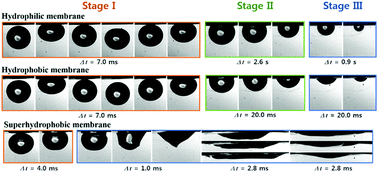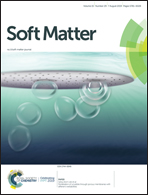Penetration of a bubble through porous membranes with different wettabilities†
Abstract
Porous structures with various surface wettabilities have been used to handle gas bubbles underwater for practical applications, such as separation, collection, detachment, and migration of the bubbles. Despite the increasing interest in porous structures, the effects of surface wettability on the behaviors of bubbles at porous surfaces have not been fully understood. Herein, we aim to examine the entire dynamics from collision to disappearance of a bubble through a porous membrane with different surface wettabilities. We divided the dynamics into three stages based on the characteristic behaviors such as bubble bouncing and contact line variation. Bubble dynamics is dominated by the existence of air layers covering the membrane surface. Bubbles on hydrophilic and hydrophobic membranes, which do not retain air layer, show the same removal pattern; they bounce on the surfaces, and then penetrate the membranes with pinned and moving contact line in sequence. In contrast, bubbles immediately penetrate the superhydrophobic membrane following the spread along the air layer. The characteristic time for bubble removal depends on the wettability, which affects the membrane permeability. The experimental characterization and theoretical analysis achieved in this work would improve the physical understanding of bubble dynamics on porous membranes and allow a proper design in bubble-related applications.



 Please wait while we load your content...
Please wait while we load your content...